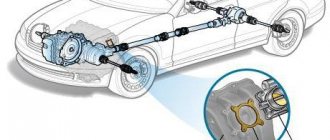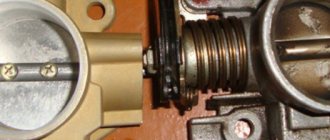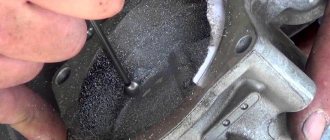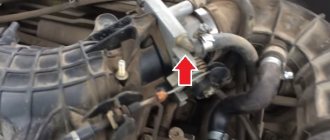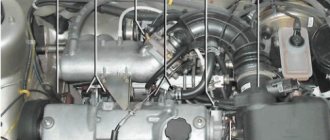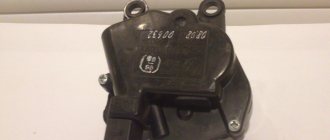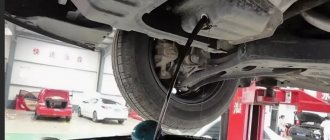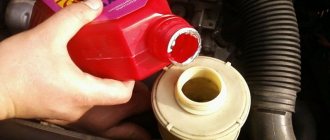In order for the car to work properly and not appear at the service station for as long as possible, except for maintenance cases, you must treat it carefully. One of the important components of the iron horse is the throttle valve. This mechanism plays an important role in the operation of a diesel or gasoline engine. And it doesn’t matter whether the power plant is carburetor or injection. The remote control can be either mechanically or electronically driven. In the latter case, sometimes it becomes necessary to adapt the throttle valve. How to do it? Let's try to figure it out, and at the same time take a closer look at the types of this node. We will also find out whether this needs to be done, and what could happen otherwise.
To remove the damper you need to perform the following operations:
- The wire is disconnected from the negative terminal of the car battery.
- The tightening that secures the ventilation hose going to the engine crankcase is loosened.
- The hose attached to the fitting of the air supply pipe is disconnected.
- The clamp connecting the pipe and the throttle becomes loose.
- The pipe is disconnected.
- The connector connecting the wires to the throttle assembly is disconnected.
- The bolts securing the throttle valve are unscrewed.
- The gasket located on the flange of the intake module is dismantled.
It should be noted that the gasket is disposable; when dismantling it, it is necessary to subsequently install a new element.
Purpose of the throttle valve
Not a single car in the world can do without such a unit as a throttle valve. The mechanism is a transverse channel regulator that changes the amount of flowing liquid or gas. That is, at its core, the damper is an air valve. When it is closed, the pressure in the intake system is equal to vacuum, and when it is open, it is compared to external atmospheric pressure.
By pressing the accelerator pedal, the degree of opening of the damper is adjusted. Accordingly, how much air enters the engine cylinders depends on this. Almost every modern car is equipped with an injection engine, where all important responsibilities are assumed by the electronic control unit (ECU).
As some car enthusiasts know, the optimal ratio of gasoline to air is 1:14.7. By detecting the throttle position and the amount of air using sensors, the ECU regulates the operation of the injectors and fuel pump. This knowledge will be useful in deciding how to adapt the throttle valve.
In other words, the computer commands how much fuel needs to be supplied to the engine in order to maintain optimal proportions.
Resetting and setting service intervals
In more or less modern cars, it is possible to set the mileage before service, when the tidy will remind the driver to go and change the oil. The standard interval is 15,000 km.
Resetting the service interval
Firstly, resetting it after changing the oil with VAG-COM goes like this:
- Login to Dashboard
- Adaptation button
- 2nd channel
- Save existing value
Setting the service interval
And setting the intervals (depending on the car!, instructions are given for common A4 8E bodies):
- Login to Dashboard
- Adaptation button
- Channel 42 (minimum value, thousand km)
- Channel 43 (maximum value, thousand km)
- In each of these channels save the required values
Accordingly, if, for example, you write the number 5 in the 42nd channel, and 7 in the 43rd channel, it turns out that after 5 tkm the indication “2 tkm before service” will light up, and at 7 tkm a persistent recommendation to go to the service will appear
Additional service display settings
On those devices where In1 or In2 (ln1 ln2) lights up:
In a vag coma:
- Block 17 - toolbar (instrument)
- Button 10 - Adaptation
- Channel 05 - OIL in thousands of kilometers
- Channel 06 - In1 in thousands of kilometers
- Channel 07 - In1 in tens of days
- Channel 08 - In2 in thousands of kilometers
That is, an example: we go to channel 6 and set it to 10. 10 means that the next time In1 will light up after 10 thousand km.
We thank MrKrabs for the second part of the description.
When and how to do it yourself
When to do it
adaptation of the throttle valve zero and adaptation of the misfire diagnostic function:
- After replacing the ECU controller or resetting the controller using a scan tool.
- After replacing the throttle assembly.
Throttle zero adaptation procedure
:
- When the car is stationary, you must turn on the ignition, wait 30 seconds, turn off the ignition, wait until the main relay turns off.
Adaptation will be interrupted
, If:
- the engine turns over;
- the car is moving;
- the accelerator pedal is pressed;
- engine temperature is below 5 °C or above 100 °C;
- Ambient temperature is below 5 °C.
Adaptation procedure
Misfire diagnostic functions:
- warm up the engine to operating temperature (parameter value “Coolant temperature” = 60.90 °C);
- accelerate the car in 2nd gear until higher crankshaft speeds are reached (parameter value “Engine crankshaft speed” = 4000 min-1) and perform engine braking (“Engine crankshaft speed” = 1000 min-1);
- Perform engine braking six times in one trip.
The simplest way to carry out adaptation
Now the question of whether it is necessary to adapt the throttle valve after cleaning should definitely not arise if there were still doubts. The easiest way to carry out the operation is to simply reset the battery terminal. Just to begin with, it is worth warming up the engine well to operating temperature, for which you should take a short trip. Then, turning off the engine, disconnect the negative terminal of the battery and wait. Depending on the brand of car, the waiting time can be 10-30 seconds or 15-20 minutes.
During this period, all ECU parameters should return to the original (factory) settings. Next, all that remains is to connect the terminal and start the engine - the speed should return to normal.
Throttle learning not at idle - what is this process?
When the throttle assembly of any modern vehicle operates, a lot of contaminants in the form of dust, soot, and oil gradually accumulate on the surface of the throttle. They form a layer of dirt, which makes the air gap between the damper and the car's air duct smaller than the established norm. This gap is important for the normal functioning of the “heart” of the car, since thanks to it the idle speed is maintained at the required level.
When it decreases, the vehicle's electronic control unit (car computer) slightly opens the damper by introducing coefficients that take into account changes in its cross-section. Up to a certain point, the ECU manages to maintain the air gap at a constant level, but sooner or later the throttle valve will still have to be cleaned of dirt. After flushing this unit, the engine speed will certainly increase due to the fact that the cross-section of the throttle, freed from the contaminant layer, will become larger.
The procedure for returning to the initial (set by the manufacturer) position of the damper is usually called training or adaptation.
Mechanical throttle
Currently, a mechanically driven damper can only be found in budget car configurations. In such a mechanism, the damper is connected to the accelerator pedal via a metal cable, fixed to the shaft and placed in a housing on which sensors are also located:
- idle air controller (IAC)>;
- throttle position (TPP).
All this looks like a separate block. Various pipes also lead to it; coolant is supplied and discharged through one, and through others the crankcase is ventilated and fuel vapors are captured.
Thanks to the IAC, the required number of crankshaft revolutions is maintained when the damper is closed. The regulator itself consists of a stepper motor and a special valve. Together they regulate the amount of air, regardless of what position the throttle valve is in. Usually there are no problems regarding how to adapt the throttle valve in the case of a mechanical drive.
Signs of throttle adaptation
The throttle valve in its modern form is one of the last components to undergo electronic modernization. Instead of mechanical rods, a compact electric motor is installed on it, which serves as an actuator.
The signal to it comes directly from the throttle sensor. Together, this system allows you to control the engine correctly, supplying the required volume of fuel mixture to the combustion chambers in a timely manner. There are several signs by which you should start adjusting the throttle position.
For example, when you suddenly release the gas pedal, the engine does not go to idle and stalls; the following can also happen:
- Unstable engine operation at idle;
- a significant “freezing” of revolutions around the 1.5 thousand mark;
- drops in speed when gaining power;
- the “CHECK ENGINE” indicator lights up on the dashboard;
- difficult start at ;
- lack of response when pressing the gas pedal.
Depending on the engine type, there may be a slight loss of power, for example with engines with a V8 configuration. Also, fuel consumption almost always increases. These signs appear especially often on cars with a mileage of 30 thousand km or more, equipped with turbocharging.
Recommendations
Comments 62
I understand that it is necessary to open the floor of the injector?
No, everything is extremely simple. Remote control mounting - 2 nuts in total
How long is the nut?
The last picture is very interesting. It turns out that the lower pipe goes from the throttle to the small crankcase breather? And the upper pipe goes from the throttle to the receiver, as I understand it?
Yes, the low ventilation and adsorber pipes have been swapped. This was done on the repeated recommendation of Drayvovites.
I don’t have an absorber (Can’t this modification be done without it?)
They suggested that I transfer the low ventilation pipe to a free fitting on the plastic intake manifold. But I wasn’t impressed with the piece itself - it’s a little poorly made, without wedge-shaped chamfers
Somehow, in the open spaces of the drive, I already read about a similar modification, more precisely about the transfer of the low crankcase ventilation hose... Since there is no absorber, I’m thinking. And if you just transfer the lower throttle pipe into the engine where there is a small breather or whatever it is called... And transfer the upper pipe from the throttle to a plastic receiver?
I won’t say anything intelligible, it’s not my topic. Highly recommended - did it. It didn't get any worse.
I fucked with it... the first time I figured it out, but the second time I didn’t think about it... but it started spinning due to vibration and more air began to flow... as a result, the edges on the damper were worn out and it began to suck a lot of air. had to change
It turned out to be a good thing)
Test. If the space allows, another grower would not be a problem.
The place is at its limit. There will be no grower
Can you tell me more about the initial opening angle? I just have that hemorrhagic problem with him. Once upon a time, when the 54th damper was installed, one mechanic decided to adjust it and climbed where it was not necessary. It seems like the angle was set, but something was wrong.
This is only 1-2 degrees. I made sure that the damper was in the stop position, that is, completely closed, but not jammed. Started it up and warmed up the engine well. Tracking IAC steps - reg. Use the screw to slightly open the damper until the steps are reduced to 25-35 from 45-50. That’s all the adjustment. The TPS voltage varies within 50-100 mV no more. The initial position of 0% is retained. During the adjustment process, it is worth turning off the engine, waiting for the ECM to turn off and starting it again - to perform adaptation to “0” TPS
I did this, then the gap turns out to be very large and at 25-35 steps the revolutions begin to float. Stable only from 35-45. Moreover, if the gap is too large, the traction deteriorates. Those. It feels like the motor is wrapping an elastic band around itself. I reduce the gap, everything is ok, but the steps reach 50.
I have no complaints about stability. But the failures when releasing gas have disappeared
Those. There is no specific panacea in our cars?! For example, Ford has a gap of 0.05, I installed the same on ours, it seems to work, but it doesn’t seem to work.
Moreover, the reason for the appearance of the described failures is still unknown. They just appeared in May last year. Especially annoying in rainy weather with a loaded generator.
Torque
To change the amount of torque, the electronic control unit can change one or more parameters:
- throttle opening angle
- boost pressure (if the engine is turbocharged)
- ignition timing
- fuel injection timing
- turning on/off cylinders
The amount of torque is constantly adjusted and depends on the following factors:
- engine starting conditions
- stable idle speed
- O2 content in exhaust gases
- restrictions on power and number of revolutions
- Automatic transmission (when shifting gears)
- traction control when braking
- forced idle when braking
- equipment operation (climate control, air conditioning)
- cruise control (whether the mode is on)
Features of the Lada Granta throttle assembly
The throttle valve is turned by an electric motor through a gearbox. Both are built into the throttle body. When starting and warming up the engine, as well as during idling, the flow of air into the cylinders is regulated by opening the throttle valve. The throttle position is controlled by two sensors built into the throttle body.
The throttle valve opening angle is set by the electronic control unit (ECU) depending on the estimated amount of air that should enter the engine cylinders. This takes into account the operating mode of the engine (starting, warming up, idling, and so on), the temperature of the ambient air and the engine, and the position of the gas pedal.
Control commands are sent to the throttle assembly to the electric motor. At the same time, the ECU monitors the opening angle of the damper and, if necessary, sends appropriate commands to adjust its position. As a result of the fact that the ECU simultaneously regulates the amount of injected fuel and incoming air, the optimal composition of the combustible mixture is maintained in any engine operating mode.
The electric throttle body is sensitive to deposits that may accumulate on its inner surface. The resulting layer of deposits can interfere with the smooth movement of the throttle valve, jamming it (especially at low opening angles). As a result, the engine will operate unstably and even stall at idle, start poorly, and failures may also appear during transient conditions. To avoid this, as a preventive measure, deposits should be removed with special detergent compounds during regular vehicle maintenance. A large layer of deposits can completely block the movement of the damper. If flushing fails to restore the throttle assembly to operability, it must be replaced.
A malfunction or incorrect operation of the throttle assembly may be caused by a broken contact in its electrical circuit (oxidized terminals in the wiring harness connection block). In this case, it will be possible to restore operation by treating the terminals with a special compound for cleaning and protecting electrical contacts. There are other possible causes of the malfunction:
— no supply voltage is supplied to the throttle assembly;
— signals are not received from both throttle position sensors;
— The computer cannot recognize signals from the throttle position sensors.
In these cases, the engine control system goes into emergency mode. At the same time, the car retains the ability to independently move a short distance at a slow speed, which, in extreme cases, will allow it to be moved to a safe place
The fact that the throttle assembly is operating in emergency mode may be indicated by a burning indicator lamp for a malfunction of the engine management system and an increased speed of the crankshaft at idle (about 1500 min-1, despite the fact that the engine is warmed up to operating temperature), the engine at this will not respond to pressing the gas pedal.
Each of the throttle position sensors is a potentiometer. During operation, gradual wear of conductive paths and moving contacts occurs. Over time, wear can reach such an extent that the sensor cannot function correctly. The presence of two sensors increases the reliability of the entire unit.
If only one sensor fails, the warning lamp will light up, but the engine management system will switch to backup mode. In this case, the engine will respond adequately to pressing the gas pedal, but with worse performance parameters
The reserve mode allows you to drive your car to the repair site under your own power.
Checking the readings
A car enthusiast who decides to independently adjust the throttle position sensor should remember that this should be done on a warm power unit. First you need to decide on the structure of this device. To adjust, you will need to find 2 connectors. The one at the top is the connector of the sensor itself, it is brown. Below it is the sensor enable connector. It is usually marked in gray. But some models may have different markings.
Next, the device readings are checked. The engine starts and warms up to operating temperature. First of all, check the input signal. To do this, pierce the rubber seal on the upper contact with a needle, connect the positive terminal of the multimeter to it, and take the negative terminal from the engine. The readings should be quite definite, although slight deviations may be allowed.
The voltage will be as follows (engine running):
- Power wire - 5 V;
- Idle speed – 0.5 V;
- At 2000 rpm – 0.55-0.6 V.
With the engine off but the ignition on:
- Starting position, damper closed – 0.7 V;
- Pedal depressed (damper fully open) – 4 V.
In this case, the voltage should gradually increase as the damper opens. When carrying out voltage measurement work, be as careful as possible. Remember that any awkward movement can lead to a short circuit and failure of all electronics.
To check the functionality of the sensor, measure the resistance at the terminals. This is done with the engine not running. The readings of a working sensor should be as follows:
- Damper closed – 0.8 kOhm;
- The damper is open - 4.7 kOhm.
When the readings differ, adjustments should be made. If there is no voltage at all, check the wiring. If the resistance is too high, it is better to change the sensor; most likely, a breakdown has occurred. In all other cases, the throttle position sensor is adjusted.
Conditions for carrying out the idle speed adaptation process
Before starting training, a number of prerequisites must be met:
- travel by car for 10 minutes;
- ensure that the battery voltage at idle is at least 12.9 V;
- warm up the gearbox;
- The wheels of the vehicle must be straight, the steering wheel must be in the middle position;
- engine temperature – 70–95 °C;
- all devices that put a load on the car’s electrical network (heated windows, headlights, etc.) should be turned off;
- The automatic transmission selector is set to N or P.
Initial conditions
Mitsubishi Lancer 9 how to clean the throttle valve
Before starting operations, make sure that all the conditions listed below are met.
This process is canceled if any of the conditions are not met at the time of execution.
- The battery voltage is not lower than 12.9 at idle.
- Temperature from 70 to 99 degrees.
- Selector in P or N (automatic transmission).
- Electrical loads are turned off (air conditioning, headlights, heated rear window, cars with Eurolights - turn on the dimensions).
- The steering wheel is in the middle position - the wheels are straight.
- Before training, drive a car for 10 minutes.
- The radiator fan should not work.
- Vehicle speed: The vehicle is stationary.
- Gearbox: Warm up.
Causes
The most common reason for an adaptation to be made is the consequences of throttle valve maintenance. As a result of operation, a large amount of deposits forms in this unit, therefore, after flushing, the position of the throttle valve changes, and the ECU continues to send signals about its condition until maintenance.
Over time, natural wear occurs on the resistive layer of the sensor potentiometer and the moving elements of the throttle valve; in this case, after adaptation, it will most often require replacement. It is necessary to conduct training if changes are made to the ECU settings (chip tuning), especially if operations have been performed to increase engine power.
The procedure is performed using special programs on computer equipment or without them (a strictly defined procedure, which will be discussed below) depending on the brand of car. Auto electricians must take into account the features of the model, year of manufacture, and type of ECU installed on the vehicle.
More about the car
Volkswagen Passat B5 is one of the most popular fifth-generation car series from the Volkswagen auto company. This generation was first shown on the car market back in 1996. If we compare them with the models that were released back in 1988, then this time the developers unified the series with the same type of Audi model (models A4 and also A6). This decision made it possible to purchase a car with a couple of levels more power and modern power indicators than Audi, but with an oblong layout. This model is available on the market exclusively with a sedan body and five-door station wagons, which are equipped with cylinder gasoline and diesel engines, starting with an increase in power from 90 to 193 horsepower (following the example of the fifth-generation station wagon diesel).
Around 2001, this series of cars underwent a facelift and its name was changed to Volkswagen PassatB5+. This change was purely cosmetic, but if you look at it visually, the updated headlights, bumpers, rear light sensors and the addition of chrome to the trim gave the series the appearance of a completely different car.
On the Russian car market, the most common are the fifth series of cars with ADR and TSI engines. If you are interested in what is the difference between them, then continue reading this article and you will soon find the answer to this question.
Throttle valve Volkswagen Passat B5
Self-cleansing procedure
If the damper is electronically actuated, then it is better to remove the negative terminal of the battery. Next, you can do everything according to simple instructions:
- dismantle the air filter by unscrewing the pipe clamp;
- disconnect all connectors of the throttle module and other pipes;
- move the air filter receiver to the side so that it does not interfere, and begin cleaning the damper;
- upon completion, reassemble the damper module in reverse order, checking that everything is in place;
- After assembly, start the engine and check the idle speed.
In some cases, before you begin to adapt the throttle valve on a Toyota, Nissan or Skoda, it is necessary to remove the throttle itself, which allows you to completely clean the valve. To do this, you will need a 5 mm hexagon to unscrew the 4 fasteners. Removing the throttle should be done with great care, as there is a risk of damaging the gasket.
If, after cleaning the throttle body, increased idle speed is observed, it means that the damper needs to be adapted.
Owner reviews
Owners of LADA XRAY who independently performed the throttle valve zero adaptation procedure note that the car stopped twitching and acceleration became smooth.
Some reviews from Drive2.ru (link to post):
I don’t know about others...But it REALLY helped me! Not long ago I got into an Xray and thought that I had forgotten how to drive a manual transmission! There were jerks with almost every shift. Yesterday I read the post and after work I spent 5 minutes on this procedure... And lo and behold, he stopped twitching! Today, driving around the city was absolutely fantastic... even the consumption dropped... but I think it’s due to the change in pedaling... So I definitely recommend doing it.
It really works! This morning I did this operation and the car drove much better, especially at low speed. Why is this not done during pre-sale preparation?
I’ve been suffering with this problem for half a year, but here it’s 3 minutes! I even wrote to AvtoVAZ, they sent me... to the dealer.) Now, after carrying out the above mentioned manipulations, I’m driving for the second day without twitching!
In the morning I carried out these manipulations at an ambient temperature of -10 and an engine temperature of 50 degrees. The car is unrecognizable - all the twitching is gone. Acceleration became smooth, and fuel consumption seemed to drop slightly. I rode all day long.
Let us remind you that we previously published an information letter from AVTOVAZ, which tells us what to do in case of vibrations and jerks when starting off a LADA car.
Key words: ECM Lada XRAY | ECM Lada Vesta | ECM Lada Largus | ECM Lada Priora | ECM Lada Granta | ECM Lada Kalina | ECM 4x4 | esud niva | universal article
2 0 4 0 0 0
Share on social networks:
Throttle learning idle
After flushing the unit or reflashing the ECU, the throttle valve should be trained to idle. To do this, fulfill the following conditions:
- check the voltage on the battery with the engine off, it should be at least 12.9 V;
- the coolant temperature should be in the range from 70 to 100 degrees;
- the steering wheel must be in a neutral position;
- The gearbox oil must be warmed up;
- all electrical consumers are turned off;
- automatic transmission handle in position P.
Failure to comply with the above requirements will lead to incorrect operation of the engine, so they must be followed. After warming up the engine, you must:
- turn off the ignition for 10 seconds;
- make sure that the accelerator pedal is in the up position;
- turn the key to the ON position for 3 seconds (do not start the engine);
- Press the gas pedal all the way 5 times within 5 seconds and release it for the last time;
- after 7 seconds, press the gas pedal all the way and wait until the “CHESK ENGINE” display lights up continuously;
- After pausing for 3 seconds, release the gas pedal.
Try to start the car, the attempt can be repeated several times. During stable operation, rev the throttle several times and the idle speed should return to the acceptable range.
The procedure for learning the throttle using a PC and car programs has its own specifics, depending on the brand of car, etc. Therefore, it makes no sense to describe the entire process in detail. But first you need to install special software on your PC, for example, VAG-COM for a VAG car group (or other) and drivers. The following is the standard connection order for all:
- turning on the ignition;
- connecting the PC to the car diagnostic connector with an information wire;
- launching software on a PC;
- conducting a test;
- receiving information about readiness for further work - the inscription: “The adapter is ready for work.”
Following a special algorithm, you will be able to coordinate the remote control and the ECU in the “throttle fully open/fully closed” modes for cars with both an electronic and mechanical gas pedal. In this case, the throttle valve training is carried out when the car is warm and the above requirements are met.
- Features of the Lada Granta throttle assembly
- Electronic gas pedal Lada Granta
- Malfunctions of the electronic gas pedal
- Cleaning the electronic throttle valve E-Gas Lada Granta 16V
Adaptation using the example of some cars
Another method, which we will consider using the example of one well-known German brand, also involves adaptation without a computer. Here you should warm up the engine to a temperature of approximately 70-99°C. The battery voltage must be at least 12.9 Volts when the engine is not running. The action plan for how to adapt the throttle valve on a Volkswagen will be something like this:
- After warming up and turning off the engine, you should wait a short period (5-10 seconds).
- With the gas pedal released, turn on the ignition and wait 3 seconds.
- After 3 seconds, you need to press the accelerator pedal all the way 5 times and release it back. Act quickly, as you only have 5 seconds to do this.
- After the 5th exercise, you should wait a pause.
- After 7 seconds, press the pedal all the way again and hold it in this position until the “CHEK” indicator starts flashing (≈ 10 sec.), then it should remain on continuously (≈ 20 sec.).
- When the indicator lights up constantly, count to three and only then release the pedal.
- Start the engine (repeat if necessary), wait 20 seconds, then lightly accelerate (2000-3500). If the tachometer shows 700 rpm at XX (+- 50), it means that the adaptation was successful.
In this case, it is necessary to strictly adhere to the time intervals of each setting step. This is the only way the ECU training will go smoothly. But before that, it’s worth studying the adaptation features and the possibility of a manual procedure for your car. Perhaps only service station specialists can help.
Need for maintenance
The prophylaxis procedure should not be carried out in the absence of obvious reasons. Before starting, you need to carefully evaluate the condition of the throttle valve. If there are no obvious signs of tar deposits and areas of coking, then the reason for unstable operation may lie elsewhere.
Also consider the mileage of the car. Experts recommend resorting to flushing no earlier than after 100 thousand km. But on some cars, for example, a Ford Focus, it may be necessary to flush it after 30 thousand kilometers.
You should know how to clean your throttle body to achieve the desired result. This requires a special carburetor cleaning solution, for example, Abro Carb & Choke Cleaner or similar products. The assembly must be dismantled; only in this case can the maximum effect be achieved, otherwise carbon deposits will remain inside the tubes. Disconnect all pipes from the throttle valve to gain good access to the inlet part of the assembly.
Remove carbon deposits delicately using a clean rag or soft brush. Do not use excessive force; you may damage the valve. The internal elements are coated with a thin layer of molybdenum, which novice car enthusiasts mistake for harmful deposits.
The consequences of zealous cleaning can be different: the moving part of the damper will begin to bite, or vice versa, in the closed position it will begin to let air through. In this case, it will not be possible to do without repairing the throttle valve.
Cleaning the remote control
If the cause of unstable engine operation is a dirty damper, you should move on to cleaning it. To do this, you can contact a reliable service station. Among the large number of workshops, you can find one that specializes in specific brands (Audi, Volkswagen, Toyota, Mercedes and others). However, the owner can do all the work himself, since much experience and skills are not required in this matter.
At service stations, the cost of the procedure may depend on a number of factors:
- complexity of the work - for some cars, access to the remote control will require the dismantling of many parts;
- service station service level - as a rule, the larger the organization, the more expensive it is;
- location – in large cities you can leave more money than in the periphery.
Cleaning the throttle valve is a simple procedure, after which you usually need to think about how to adapt the throttle valve on a Nissan or any other car.
Any car owner can perform this procedure independently. No special knowledge or skills are required here. All you need to get to the damper are tools and rags (preferably soft ones). You also cannot do without a special product - mainly the carburetor cleaner “Carb Cleaner” is used.
Gas pedal with mechanical throttle control
In the mechanical throttle control drive, a cable is attached to the gas pedal, which goes directly from the passenger compartment to the engine compartment and the other end is screwed to the throttle control drive (a semicircular iron part next to the throttle). When you press the pedal, the cable stretches and pulls this part, which is directly connected to the throttle valve and is usually located on the same axis of rotation with it. The damper slightly opens or closes the pipeline through which air is supplied to the engine. The rest is done by electronics. To achieve the desired torque, the electronic unit changes the ignition timing and the timing of fuel injection into the combustion chamber. This regulates the fuel-air mixture and achieves the required torque.
Electromagnetic throttle valve
The electronic analog, unlike a mechanical unit, allows you to achieve the optimal torque value in any engine operating mode. The level of fuel consumption is reduced, and driving such a car is comfortable and safe. The main distinctive features (and in this case, advantages) are the following:
- idle speed is controlled by moving the throttle valve;
- there is no mechanical connection between the pedal and the damper.
Due to the fact that there is no mechanical connection, torque can be controlled electronically instead of the gas pedal. The damper module itself consists of the following elements:
- housings;
- the damper itself;
- electric drive;
- return spring mechanism;
- damper position sensors.
Installing not one, but two damper position sensors in the module will improve reliability. For this purpose, magnetoresistive devices or potentiometers with sliding contacts can be used. It is precisely because of the breakdown of these elements that it is necessary to decide how to adapt the throttle valve on many cars.
If a malfunction occurs in the electric drive, the damper is brought to the emergency position due to the return spring mechanism. In this case, the module itself must be replaced, which can only be done as an assembly.
Electronic gas pedal Lada Granta
On modern cars, instead of the usual cable drive for throttle control, a so-called “electronic gas pedal” is installed. In such cars, the throttle position is controlled electronically. When you press or release the gas pedal, information about this goes to the control unit (ECU) and only after processing and adjustment is a command given to the throttle module. The pros and cons of such a system, as well as signs of malfunctions, will be discussed in this article.
For those who are accustomed to mechanical drives, where pressing the gas pedal directly causes the throttle to move, driving a car with an electronic system will be unusual and unknown. To understand, you need to understand the principle of operation of the “electronic pedal” and its difference from a conventional mechanical one.
When is the damper adaptation performed?
The need for such an operation, which involves bringing high idle speeds to a standard value, arises not only after flushing the throttle assembly, but also in other cases, in particular in the following:
- after the vehicle battery is completely discharged;
- after replacing or removing the accelerator pedal;
- after replacing or reconnecting the vehicle's electronic control unit.
Undoubted signs indicating that the damper needs to be trained immediately are the following phenomena:
- whistling when revving;
- inadequate behavior of the engine at idle;
- lack of power at idle or failures.
Getting rid of engine vibration part 2. Throttle revision
1 Cleaning and lubricating the throttle
Recently, the car has become very annoying with the behavior of the throttle. The car reacted nervously and with a slight delay to pedal presses, the idle speed fluctuated greatly, and releasing the gas was like a blow. I went for spring diagnostics for 299 rubles. Everything is fine, no electrical problems. I checked the spark plugs and changed the fuel. There was no effect, I tried to remove and clean the throttle, but knowing AvtoVAZ I decided to look at the condition of the E gas reducer. I bought a throttle cleaner and got to work. When I unscrewed the throttle nuts, the studs came out with them. The studs are held inside the plastic manifold by nuts; they fell out. I had to look for new ones and use thread glue. The damper was crap quite badly, especially around the axis of rotation. I slightly lifted the flap and turned it; it moved with little effort and stuck. A view opened up to the end of the damper; there was a lot of carbon deposits on it, which interfered with the passage of air at idle. Hence the sausages at low speeds. I washed everything, blew it with a cleaner from the heart. The biggest surprise was waiting inside the gearbox. We open it and see a completely dry gearbox. Not a drop of grease on the gears. The idler gear shaft has wear and plastic dust from the gear. And there’s actually an oval hole in the lid! I blew it out and lubricated it, very little lubrication is needed. A little inside the idler gear, a little into the cover and onto the drive gear of the engine. We close everything and put it in place. The result is excellent. Before cleaning and inspection: — Starting the engine was accompanied by vibration and floating speed. — Idle speed fluctuated greatly from 830 to 950 revolutions, sharply and with dips. — Acceleration up to 2500 rpm was sluggish, after 2500 it was like a kick. The car accelerated faster. — The release of gas was accompanied by a strong nod, which created discomfort in the flow. — The overall reaction to the gas pedal was very sluggish. — Squeaking sound when the ignition is turned on. After cleaning and inspection: - Now the engine starts, somehow abruptly, the speed is stable, vibrations are minimal - Idle speed has become more even, floating within 860 - 900 revolutions. — Acceleration is now smooth throughout. There is no such jerk after 2500. — The throttle release is smooth, the needle falls smoothly
